Like mini fighter pilots, fruit flies can execute hairpin turns

This high-speed video shows a fruit fly performing a rapid escape maneuver in super-slow-motion. (Courtesy of Florian Muijres / Dickinson Lab, University of Washington.)
Fruit flies seem to have a preternatural ability to evade annoyed swatters. Now, laser-wielding scientists have discovered the secret of these winged escape artists: They execute speedy hairpin turns by banking in the same way that fighter jets do.
The aerial skills of Drosophila hydei, described this month in the journal Science, could provide insight into the complex neural circuitry that makes such impressive maneuvers possible — and perhaps help engineers to build better flying robots.
When in flight, these sesame-seed-sized bugs usually turn right or left on their “yaw” axis, like a boat turns in the water. But when they’re under threat and need to flee, they use a different technique to execute turns that are five times faster than normal.
Instead of turning on the “yaw” axis, the flies roll to one side and adjust their pitch (by pointing their heads up or down) at the same time. How they roll and pitch depends on where the threat comes from, the researchers found.
After sensing a threat, the flies can execute one of these turns in less than one-hundredth of a second, the scientists said. That’s roughly 50 times faster than the blink of an eye.
“It was really interesting,” said Stacey Combes, a biologist at Harvard who was not involved in the study. “This is the first time it’s been really shown how distinct different types of turning can be in different behavioral contexts, whether it’s a routine turn or an evasive maneuver.”
To figure this out, neurobiologist Michael Dickinson and his colleagues captured 3,566 wing beats from 92 distinct fruit fly escapes staged in a lab at the University of Washington in Seattle.
This was no easy task. In order to observe such infinitesimally tiny movements, the scientists had to use high-speed cameras that recorded 7,500 frames per second — roughly 40 frames for each wing beat. They also needed to flood the flight area with light without blinding the flies in the process.
So the researchers used infrared light, which illuminated the insects for the cameras but can’t be seen by human or fly eyes. All the circuitry in those lights generated more heat than the flies could handle, forcing the scientists to run an air conditioner at full force.
“There are a whole lot of wool hats worn in the lab,” Dickinson said.
The scientists watched as the flies flew through two crossing laser beams, causing their own shadow to loom large. In response to this apparent threat, the insects initiated their escape maneuvers.
The videos showed that the flies could roll more than 90 degrees to the side, sometimes going nearly upside down. They could execute these turns in less than two wing beats, which is pretty remarkable considering that they typically flap their wings 200 times per second, the scientists said.
“A lot of other people working in the field … would not have predicted the fly could rotate itself so quickly,” Dickinson said.
After analyzing the flights, the scientists developed a set of mathematical rules that described the flies’ banked turns. Then they programmed those rules into a robotic fly that was set loose in flowing mineral oil. (Because the robot was much bigger than the flies, it had to be tested in the viscous fluid so the physics would stay about the same, the scientists said.)
This kind of research could help engineers design better miniature flying robots, said Combes, who is part of a team working on Robobee, a project that aims to create tiny swarming mobile robots for a range of purposes, including field pollination and military surveillance.
“Stability, and how to turn, is probably going to be the next key challenge for getting these to a point where they can actually fly outside in all kinds of complex environments,” Combes said. “And the option of having two different types of turns might be very useful.”
The next step, Dickinson said, is to understand the complex neural circuitry that controls the flight muscles and makes such daring maneuvers possible.
“We’re very interested in how the brain can control motion on such a fine scale,” he said.
If fruit flies maneuver like tiny fighter pilots, analyzing their aerial skills should provide insight into their neural “cockpit” and reveal how their brains are wired, said Cornell University physicist Jane Wang, who was not involved in the research.
“By looking how the insects turn, we might be able to say what the ‘pilot’ is thinking,” Wang said.
Twitter: @aminawrite







